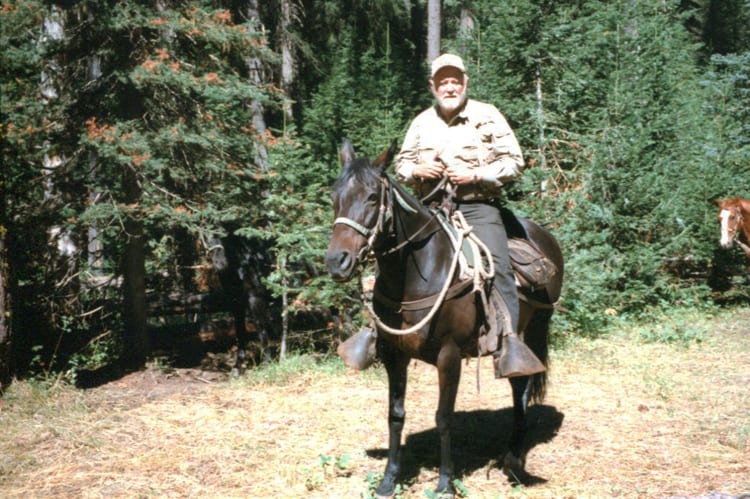
Since this could be 2023’s Old Growth Week, based on a stakeholder update planned for tomorrow with news of some MOG policy, I thought it might be fun to go back in time to the 90’s, 92, to be exact, and see how far we’ve come on the Old Growth issue. We can revisit Chief Jack Ward Thomas’s 1992 Albright Lecture. It’s interesting to think about what has or has not changed, with the increased focus on climate change, carbon and wildfire- and what hasn’t, in the last thirty years. And to think about where the issue will be in the next thirty years. Will we still be fighting about it? Will old growth be dead from climate change or burned up or …? Or will we have finally reached some kind of peace, in the direction that Chief Thomas describes.
It’s got a bit about planning and is worth rereading in its entirety, but I picked out a few excerpts below.
HA! Things Are Not What They Seem
Perhaps, further down line, it will be possible to discern exactly the attributes of owl habitat. If so, perhaps such habitat can be provided through innovative silviculture (Thomas et al. 1990).
Aha! So it is simply a question of habitat for spotted owls. If we can provide for owls with appropriate silviculture, there will be no need for reserving mature and old-growth forests. But, on the other hand, other species of plants and animals have evolved with or are disproportionately associated with old-growth. Some of these species will, almost certainly, end up in threatened status.
Aha! This is not only a question about owl habitat. It is, really, a question of old-growth management. But, the attributes of old-growth that provide the niches that support the animal species interact in mysterious ways to make up a forest ecosystem.
Aha! So, it is not really an old-growth question. It is an ecosystem question.
But, increasing knowledge indicates that the sizes, distribution, and connectivity between habitat patches are critical variables to consider in ensuring that the peculiar ecosystem retains the full inherent complement of species and ecological processes (Thomas 1979, Nass 1983, Harris 1984, and Probst and Crow 1991).
Aha! The issue is not just an ecosystem question. It is an ecosystem question and at landscape scale.
But, some people devoted to the preservation of old growth know or care little about the biological aspects of the issue. They simply see great beauty in the old-growth forests. Some perceive a spiritual value in the contact with and the existence of such forests.
Aha! So, it is not only a question of biological attributes but also of aesthetic and spiritual values.
But, if it is an ecosystem question that must be addressed at the landscape scale, what must this landscape accommodate? There are people in that landscape – part and parcel along with the plantations, the “ancient cathedral” forests, clearcuts, the elk and owls, and the streams and fish.
These people have desires, differing values, and untold aspirations that demand satisfaction. Each sees and wants different things from the landscape of which they too are part. And, they want their children and grandchildren to have these same things.
Aha! Then it really is an ecosystem sustainability question at a geographic scale where protection of nature, the production of goods and services for people, and the lifestyles of forest users must strike an enduring balance.
How do we do that?
And this..
Will the path we have been on for 50 years take us and our forests to a desired future state?
Consider the following. The first word in the pairs of words is where we have been and are. The second word is what we need to cultivate within ourselves to do a better collaborative job of stewardship. These word pairs are:
functional-interdisciplinary;
competitive-cooperative;
reductionist-holistic;
deterministic-stochastic;
use-value;
linear-interdependent;
rain in g-education;
simplify-diversify;
short term-long term;
site-landscape;
individuals-communities;
gladiator-diplomat;
rigid-flexible;
clever-wise; and
narrow-broad.
But, the fighting goes on and accelerates infrequency and intensity. The people, our sense of community, and the forest are bruised and battered in the process. The gladiators never tire of the fight – it is what they do. The fight itself provides their sustenance. I detect, however, that many concerned about forests we collectively own have long since approached exhaustion.That may be good news, for with exhaustion, there may come a willingness to seek an answer to the statement made earlier, “There must be a better way.”
That better way can be built on new knowledge and past experiences and on changes in personal and societal concepts. And, that better way can be embraced because the old way has led us to a place where we cannot stand for long.
Shakespeare said (Julius Caesar, Act 1, Scene 2) “…the fault, dear Brutus, is not in our stars, but in ourselves…”
If the fault lies within us, the solution also resides in us as well.
Jack, .. we’re still on the path you laid out.. still looking for the diplomats. If you and your upstairs associates can help, we’d like to put in a request for more of these.
Chief Thomas had most of it right. He was one of the best, in my opinion, and tried hard to do his best for our public lands forests. The division on how we should manage our forests rages on. I see many examples of the politics and money still driving the bus. One recent example is the approval of the project to build a wind generation complex in Wyoming and transport this power to California to fulfill its ever increasing need for more power. Currently forests in California contain millions of dead trees that are a huge risk of reburning and causing larger, even more destructive fires in the future. This kindling needs to be cleaned up and could be use for many things including biomass for power generation. Just one example. There are many more..